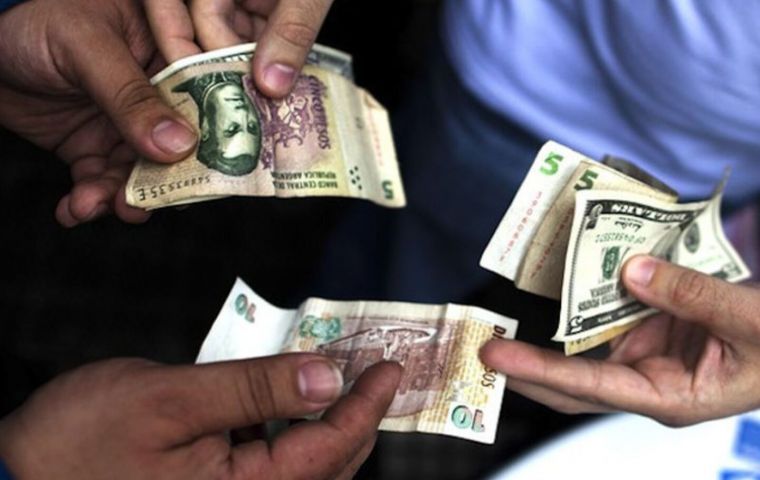MercoPress. South Atlantic News Agency
Argentina: “Blue” dollar hits new record high
 Massa is regarded as someone who can bring on stability
Massa is regarded as someone who can bring on stability The “blue” (a euphemism for “black market”) dollar closed at AR$ 493 / AR$ 498 (buy / sale) Tuesday, hitting an all-time high following an AR$ 5 increase so far this week, it was reported in Buenos Aires financial circles. At some point Tuesday it reached AR$ 499.
After closing 2022 at AR$346, it climbed AR$35 (+10.1%) in January. In February, dropped AR$6 (-1.6%). In March, it rose AR$20 (+5.3%). In April, it rose AR$74 (+18.73%), in May it climbed AR$21 (+4.5%), and in June it went up AR$4 (+0.8%). It had closed 2021 at $208 for an annual variation of +66.4%.
Argentina's Central Bank (BCRA) Tuesday bought US$9 million and got rid of more than 700 million yuan.
The gap now with the official exchange rate is 80.1%, it was also reported. The official exchange rate traded at AR$263.20.
Financial world sources quoted by local media were optimistic about Argentina, given Economy Minister Sergio Massa's pro-market profile. The Unión por la Patria (UP) presidential candidate is regarded as someone who could bring on foreign exchange stability, despite the need to control the gap with the official dollar and reduce inflationary indexes to secure a large number of votes in an electoral context.
According to the consulting firm Anker, “Massa's candidacy may have 'hardened' the IMF's position, since by negotiating with a candidate with chances, the margin to justify the postponement of measures until the next government is reduced.”
The debt with the IMF is another factor of concern within the Government. Last Friday, the Ministry of Economy paid one of July's four maturities, and the rest was rescheduled for the end of the month. It is estimated that by that time the renegotiation with the agency will be closed. With this new payment, the BCRA reserves are in the red by over US$ 5 billion.
After the currency swap with China, the Argentine Government still has approximately US$ 7,300 million in yuan, which entails a monthly trade deficit of US$ 1.2 billion over the next six months, which in theory hinders the recovery of imports prior to the adjustment at the end of last year.
According to the private consulting firm, “Without a credible macroeconomic program, the policy can only bet on trying to mitigate the consequences of the weak demand in pesos and reduce the chances of an inflationary acceleration by keeping the exchange rate gap under control.”
Other quotations for the US dollar against the Argentine peso Tuesday were:
Dollar savings (65% surcharge on retail dollar purchase): $456.27.
Dollar card (surcharge of 75% in foreign currency purchases): $483.92.
Qatar dollar (100% surcharge on foreign currency expenses over 300 dollars): $553.06. It remains the most expensive rate in the market. It is not an exchange rate for the purchase of bills, but a surcharge on foreign currency expenses with credit or debit cards.




Top Comments
Disclaimer & comment rulesCommenting for this story is now closed.
If you have a Facebook account, become a fan and comment on our Facebook Page!